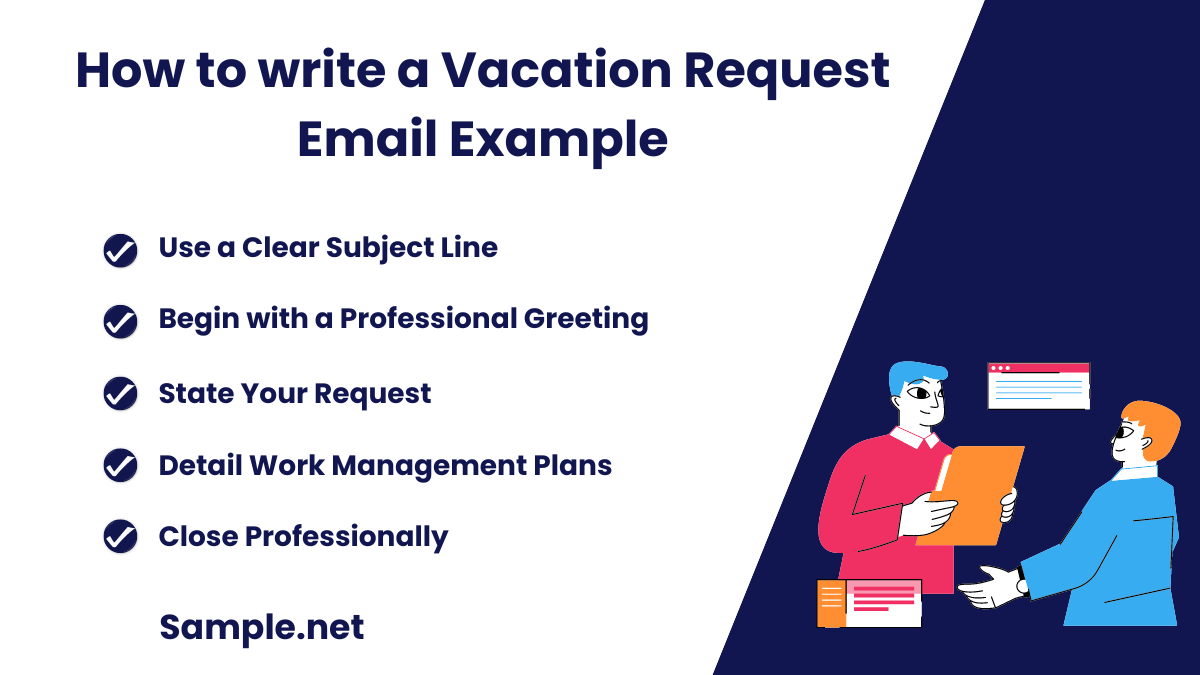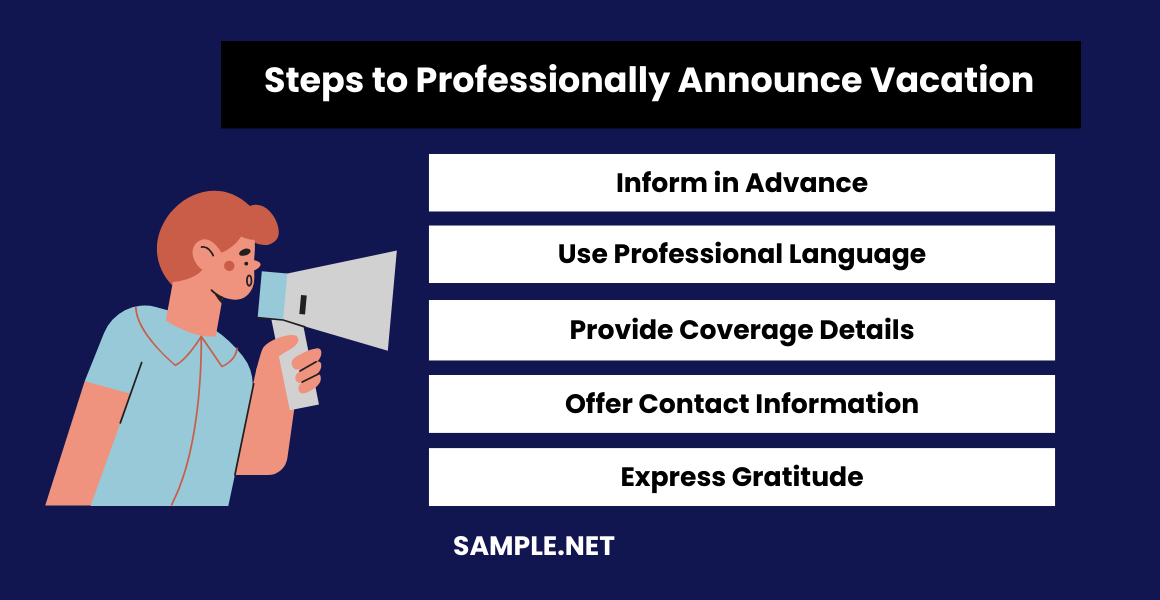Vacation Request Letter Samples
-
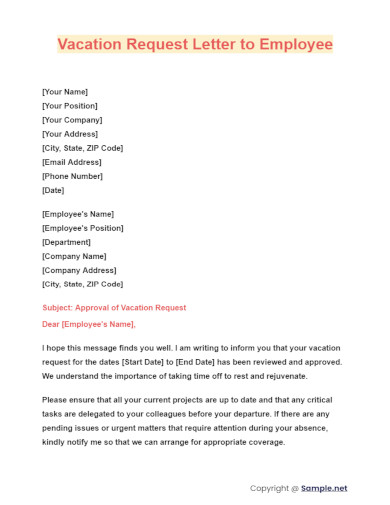
Vacation Request Letter to Employee
download now -
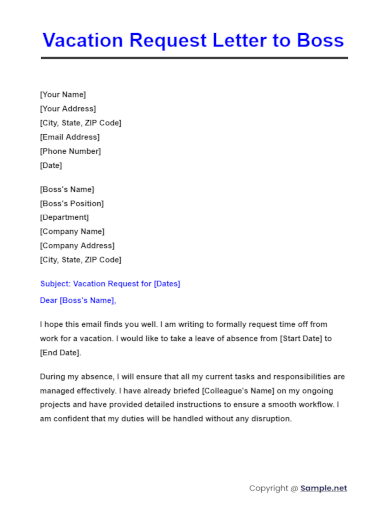
Vacation Request Letter to Boss
download now -
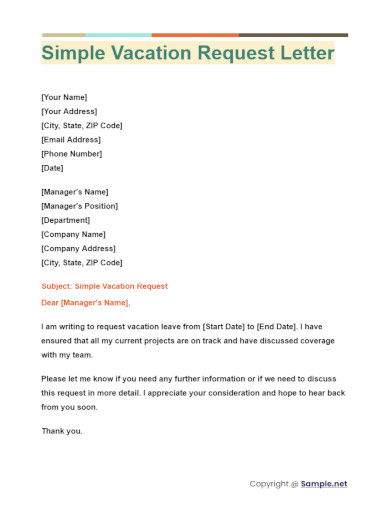
Simple Vacation Request Letter
download now -
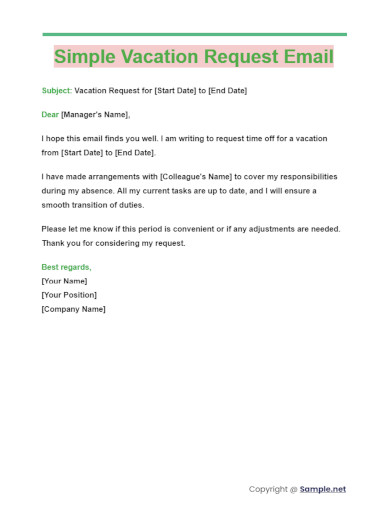
Simple Vacation Request Email
download now -

Simple Vacation Request Letter Template
download now -

Vacation Request Letter Template
download now -
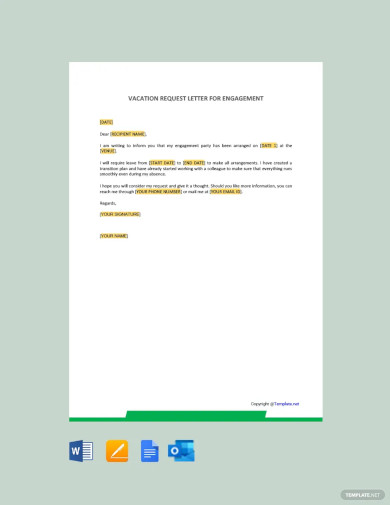
Free Vacation Request Letter for Engagement Template
download now -
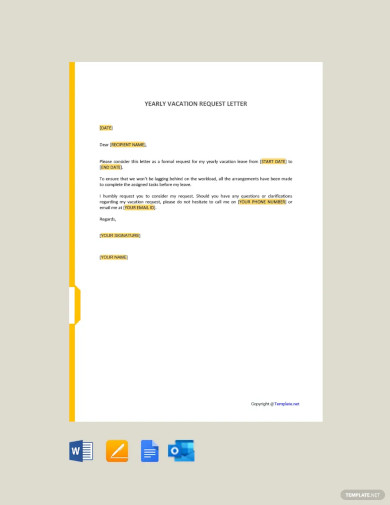
Free Yearly Vacation Request Letter Template
download now -
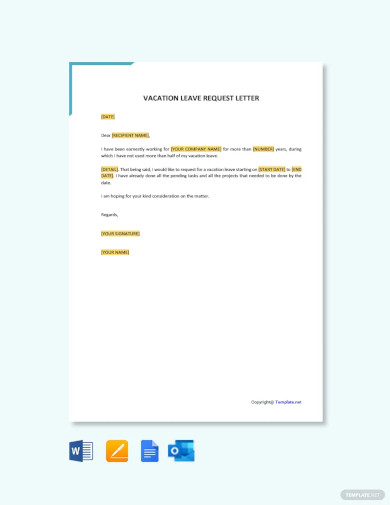
Free Vacation Leave Request Letter Template
download now -
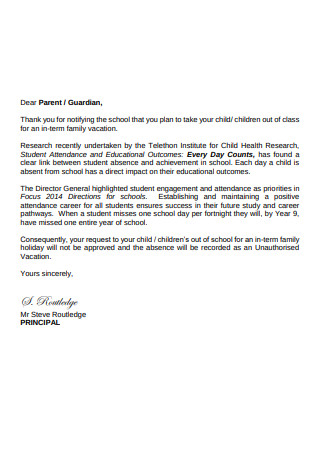
In-Term Vacation Request Letter
download now -

Request to Carry Over Vacation Days
download now -

Attendance and Vacation Request Letter
download now -
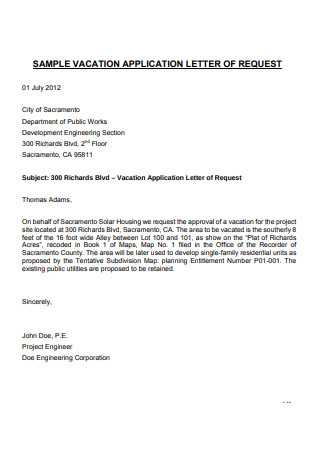
Vacation Application Letter of Request
download now -
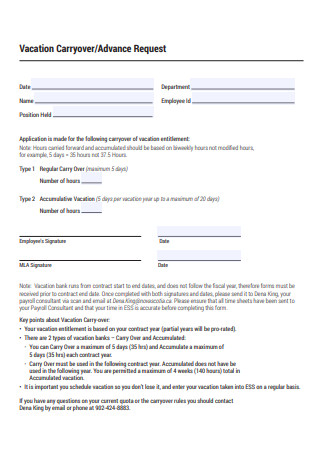
Vacation Carryover/Advance Request
download now -
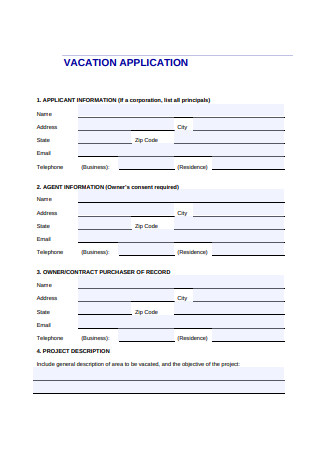
Vacation Request Application Letter
download now -
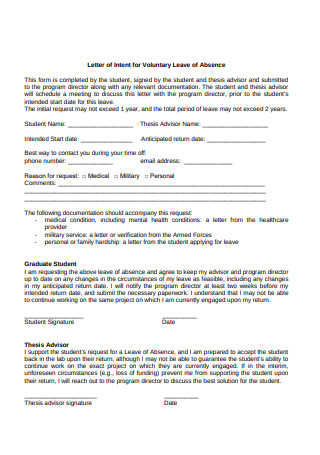
Letter of Intent for Voluntary Leave
download now -
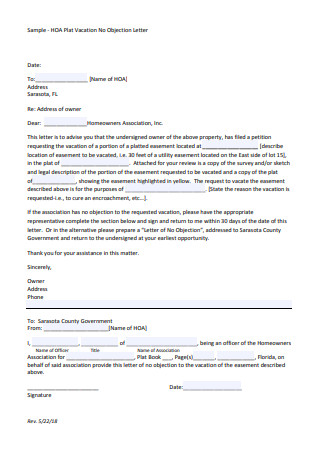
Plat Vacation No Objection Letter
download now -
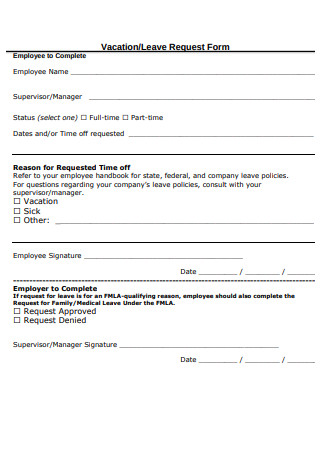
Vacation/Leave Request Form
download now -
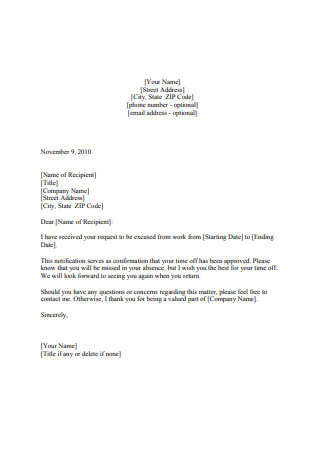
Vacation/Leave of Absence Approval Letter
download now -
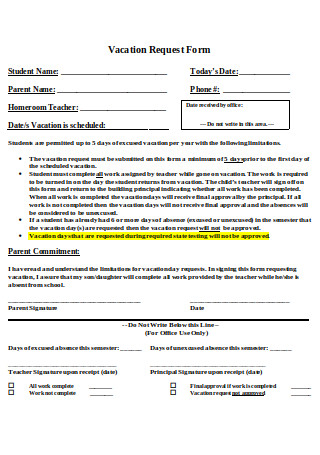
Vacation Request Letter Form
download now -

Sample Vacation Request Letter
download now -
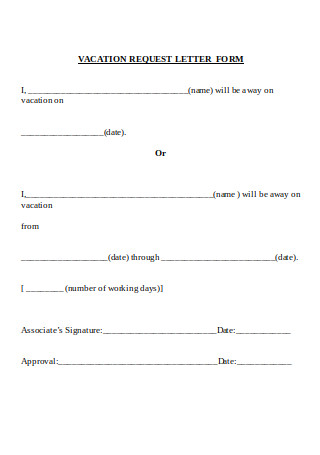
Vacation Request Letter Form Sample
download now -
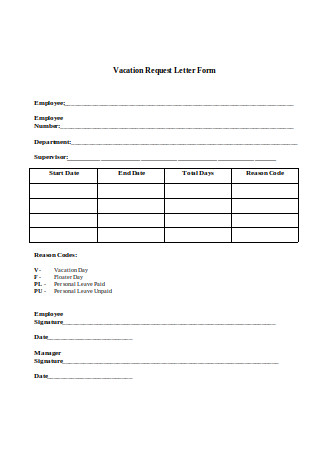
Simple Vacation Request Letter Form
download now -
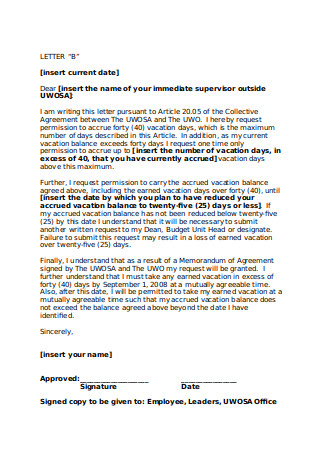
Vacation Accrual Letter
download now -
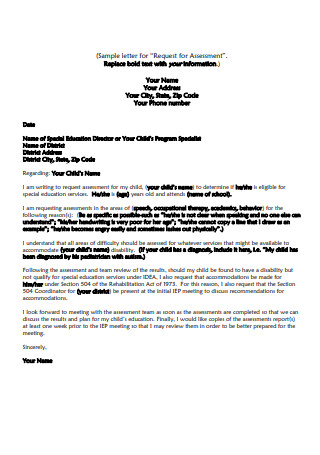
Sample Letter Request for Assessment
download now -
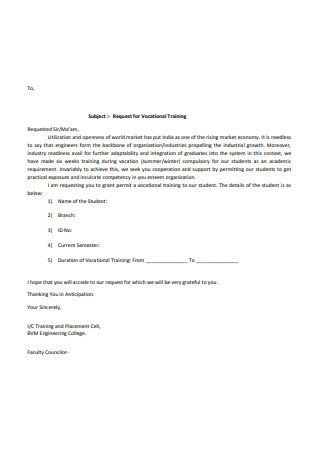
Request for Vocational Training Letter
download now -
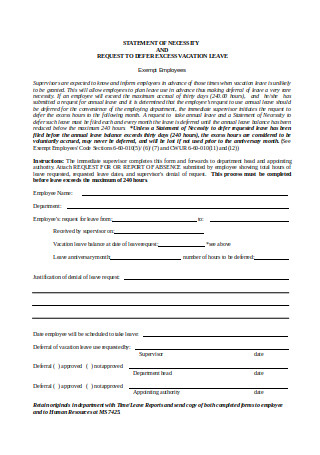
Formal Vacation Defer Request Letter
download now -
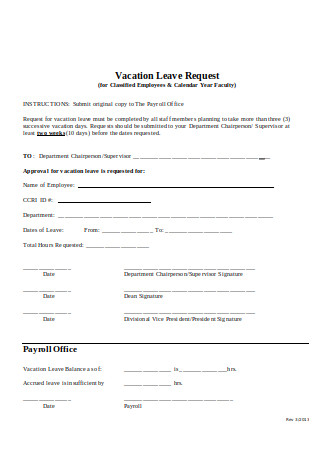
Vacation Leave Request
download now -

Vacation Request Letter & Approval Form
download now
FREE Vacation Request Letter s to Download
Vacation Request Letter Format
Vacation Request Letter Samples
What Is a Vacation Request Letter?
Elements of a Vacation Request Letter
How to Write a Vacation Request Letter
The Dos and Don’ts of a Vacation Request Letter
How do I write a letter of vacation request?
How to write a vacation request email example?
How to write a going on vacation email?
How do you tell your boss you want to take a vacation?
How do you professionally say you are going on vacation?
How do I tell a new employer about a planned vacation?
How do I write a vacation letter to a friend?
How do you politely ask for vacation leave?
How do you say vacation request?
How do you say vacation without saying vacation?
How early should you put in a vacation request?
When can I ask for vacation?
How do you start a vacation letter?
How to ask for vacation approval?
Download Vacation Request Letter Bundle
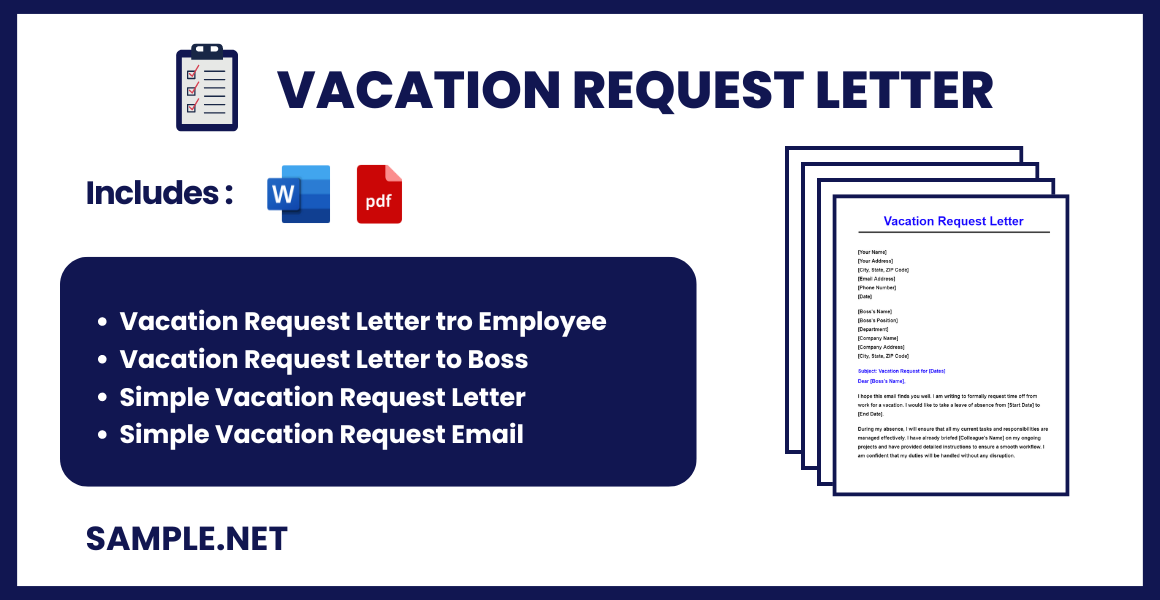
Vacation Request Letter Format
Heading
[Your Name]
[Your Address]
[City, State, ZIP Code]
[Email Address]
[Phone Number]
[Date]
Recipient Information
[Manager’s Name]
[Company Name]
[Company Address]
[City, State, ZIP Code]
Subject Line
Subject: Vacation Request for [Dates]
Salutation
Dear [Manager’s Name],
Body
Paragraph 1: State your request clearly. Mention the dates you are requesting off and the reason for the vacation.
Paragraph 2: Explain how you plan to handle your responsibilities while you are away. Mention any preparations you have made to ensure a smooth workflow.
Paragraph 3: Offer to discuss the matter further if needed and provide your contact information for any urgent issues during your absence.
Closing
Thank you for considering my request. I look forward to your approval.
Signature
Sincerely,
[Your Name]
What Is a Vacation Request Letter?
A Vacation Request Letter is a formal document written by an employee to their employer to request time off from work. It typically includes the desired dates of leave, the reason for the request, and any plans to ensure work continuity. This letter is crucial for maintaining transparency and planning within an organization.
In addition to its essential elements, a simple vacation request letter must contain the reasons for the leave and the details regarding one’s proposed absence. The goal is to convince a reader to approve your request without sounding too pushy.
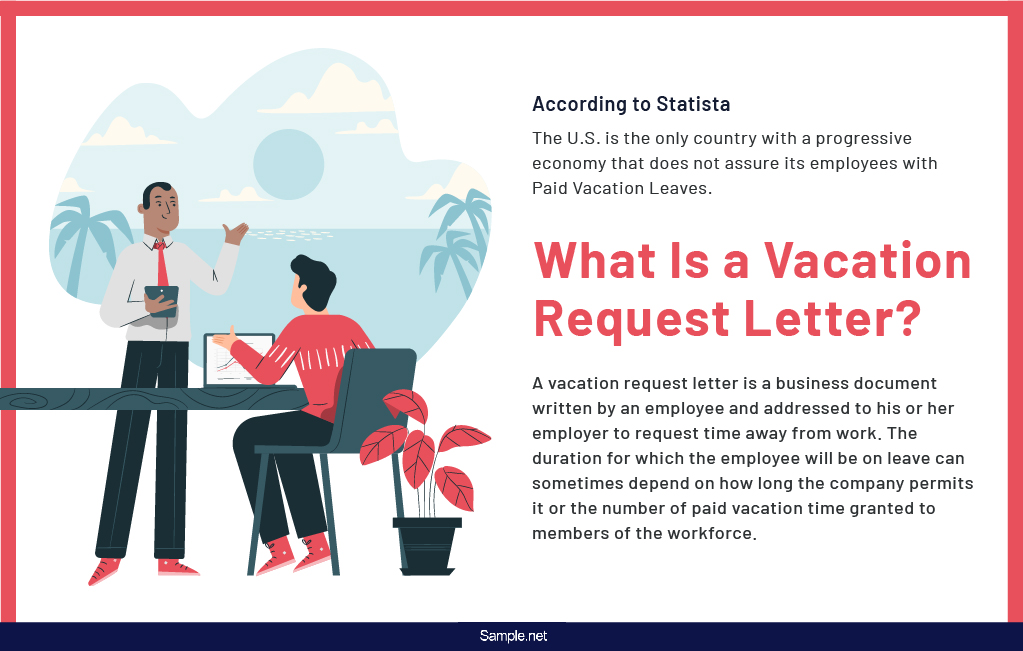
Elements of a Vacation Request Letter
Employers will recognize your vacation request letter as an official document for company records. Thus, it’s vital to secure a copy of the request letter in your computer in case the person you send it to loses the original file. As for the contents of your letter for vacation leave approval, you may want to keep the following components in mind:
How to Write a Vacation Request Letter
We all need a break every once in a while. Fortunately, most organizations provide paid and unpaid leaves annually, as reflected in their employment contracts. But to make the most of this benefit, you need to compose a letter that will encourage your boss to grant your request for vacation time. Find out how you can notify your immediate supervisor about your plans to take some time off through the steps below.
Step 1: Discuss the Terms of Your LOA with Human Resources
If you aren’t so sure about your company’s leave policy, it’s best to check with the human resources department for confirmation. You can ask about the amount of vacation time permitted to employees, the necessary paperwork to fill, and other relevant details to note down. It’s also possible to speak with your supervisor directly, so any work-related concerns may be addressed clearly and coherently. The discussion could cover any questions or potential problems that may trouble the team due to your absence. You don’t have to call a formal meeting to make this happen, but it’s still a good idea to notify your supervisor about your plan via email. Be sure to do this before sending your vacation request letter. You should also take a look at our Donation Letter
Step 2: Address the Recipient
Once you’ve educated yourself about your company guidelines for vacation leaves, it’s time to get started with your letter.
Before going to the main points of the letter, don’t forget to address the person you are writing to. Regardless of your working relationship with one another, you must address the recipient of your letter with an equal level of respect and professionalism as you would with a client. A person’s name and their respective title should be included in your salutation as well. If you aren’t sure who to address, feel free to ask your colleagues for answers instead of settling with a generic greeting. You should also take a look at our Personal Reference Letter
Step 3: State Your Reason for Writing
Avoid beating around the bush and go straight to your reason for writing the letter. You don’t need to explain why this vacation would mean the world to you, as this wouldn’t even matter if you fail to sort through the piles of paperwork sitting on your desk before sending the letter. You’ll also want to keep it as honest as possible. While this doesn’t mean giving a detailed explanation of your proposed LOA, most employers would care to know what you plan to do during your time off, especially if it’s at a critical season for the company. You should also take a look at our Contract Letter
Step 4: Delegate Unfinished Tasks to Colleagues
Be sure to cover all the necessary bases before going on vacation. As for ongoing projects and assignments on your to-do list, consider assigning these tasks to your coworkers who know a thing or two about the job. Since it’s only temporary, avoid delegating tasks that require an excessive amount of knowledge and skills to complete. The least you can do is to make it easy for them to handle your responsibilities while you’re away. Not only can this maintain a smooth workflow for the business, but it can also lighten your workload for when you get back. You should also take a look at our Confirmation Letter
Step 5: Proof the Letter
Never send a letter without proofreading it. Make it a habit to review the letter for any mistakes that could cause misinformation, especially if it involves names and dates. The letter should be easy to understand for it to serve its purpose effectively. If you’re satisfied with its content, don’t wait until the last moment to print and send it to your target recipient. You should also take a look at our Official Resignation Letter
The Dos and Don’ts of a Vacation Request Letter
Everyone deserves some time off to relax and spend time with family and friends. In spite of being entitled to some vacation time, you might feel hesitant to ask in fear of frustrating your boss and colleagues for the extra load of responsibilities that will be handed to them while you’re gone. What many people don’t seem to realize is how beneficial vacation days can be to individual productivity. Not only does it put your mind at ease after those countless overtimes at the office, but it’s also an opportunity to make up for the lost times you had away from loved ones. You should also take a look at our Letter of Support
With that said, here are some tips to remember when requesting for that much-awaited time away from work.
Dos
1. Do review your company policy.
Every organization has a written policy for paid and unpaid leaves, and you’re likely to find it in your employee handbook. Although the FMLA Act of 1993 mandates every employer to conform to state and federal laws, companies do have the right to establish their own rules regarding leaves of absences.
According to the Bureau of Labor Statistics, private industry workers in the country are typically granted an average of 10 paid vacation days a year after their employment. The only way to find out if your employer offers the same is if you take the time to ask beforehand. Presenting your request letter per company policies can often increase your chances of getting an approval. You should also take a look at our Letter Of Explanation
2. Do find the best time to ask your boss.
Timing is crucial in this case. You’ll want to catch your boss in the best mood, so try not to ask for time off when the company is at a crisis or after a heated argument with a shareholder. You’ll also want to avoid month-end operations when everyone is on the edge of their seats with business reports and project deadlines. To put it simply, avoid stressful circumstances. You can also consider emailing your boss directly to make the request or setting a brief meeting for a thorough discussion. What’s important is that you are aware of your company’s leave system and policies upon making the request. You should also take a look at our Apology Letter
3. Do ask politely.
It’s only appropriate to be courteous in your request letter. You don’t want to sound demanding in any way, given that you’re still awaiting the notice of approval from your boss. Keep in mind that it’s not a done deal until your supervisor gives you the green light. Hence, make sure that your request letter is just that—a request. Avoid making any references to your vacation plans, especially if you made them before requesting your time off from work. A proper greeting or salutation is also a plus in writing the content of your letter. You should also take a look at our Explanatory Letter
4. Do make the turnover easy for your replacement.
It doesn’t matter how long you’ll be away from the office; somebody has to take your place temporarily to ensure that the business continues to run smoothly even in your absence. The least you can do is prepare a gameplan that your replacement will find useful. You can indicate these responsibilities in your request letter, along with other reminders that one must take note of. Be sure to inform your clients in advance in case they have any questions or concerns that need to be addressed while you’re away. You should also take a look at our Board Resolution Letter
5. Do set a reminder the week before.
Though this is done sometime after the request letter had been sent to and approved by your supervisor, it’s still an action that some employees frequently forget to make. You must take the time to remind your colleagues and leaders about your time off from work, especially when last-minute assignments start filling your calendar only days before your LOA. Don’t assume that your coworkers will have the time and energy to accommodate some extra work without prior notice. Ultimately, it is your responsibility as an employee to address any work-related concerns before your vacation begins. You should also take a look at our Letter of Employment
Don’ts
1. Don’t catch your boss by surprise.
Itching to grab that discounted airline ticket to Bali? You may want to think twice before booking your flight. It’s never a good idea to purchase tickets to a place or event unless you’ve earned the permission of your supervisor for the planned dates. But even if you already made your bookings ahead, you don’t want to make it seem that way in your request for vacation leave letter. There’s a vast difference between asking if you could take time off from work and informing your boss that you won’t be at the office during such time, in which the latter would be something you’ll want to refrain from doing.
2. Don’t make it too long.
Avoid a lengthy vacation request letter at all costs. It’s a good idea to be as specific and direct as possible so recipients can quickly grasp the point you’re trying to convey after reading the first few lines of the letter. You don’t have to impress your boss with complex language to earn their approval, as long as you comply with your company procedure, you should be fine. Listing responsibilities and other reminders in bullets is another technique that you could use to break down points into digestible parts.
3. Don’t do it at a critical time.
If possible, make sure to work around your schedule before making the request. See to it that your vacation time does not fall in the busiest time of the month or year, especially if your position in the company plays a huge role in its overall operations. As for matters that you have no control over, be sure to explain your leave of absence. A wedding, birthday, or baptism of a family member or a close relative is often acceptable. It might come as an inconvenience for the rest of the team, but a clear and reasonable explanation could get you off the hook.
4. Don’t ignore your responsibilities at work.
If you’re going to be gone for a couple of days, you need to find someone who could cover for you while you’re away. Employers often encourage their employees to assign temporary replacements who are most familiar with one’s workload. It could be a partner, a teammate, or even your department head if they have the time to complete a few tasks on your behalf. You could leave a few notebooks and journals on your desk for your temporary replacement to use as a reference when accessing client accounts and other related files in the system.
5. Don’t waste it.
If you’re lucky enough to work for an employer that offers a certain number of paid vacation leaves per year, be sure to use as much as you can within the allotted period. These benefits exist for employees to enjoy, so despite your workaholic tendencies, you might as well use them before you end up losing these leaves when the fiscal year renews. You can review the amount of vacation time granted by the company through your handbook. You can also have this concern verified by someone from the HR department in case you missed it during the onboarding orientation.
Regardless of your reason for requesting some vacation time, don’t be afraid to approach your supervisor to have it settled. Going on a long-awaited break from your job can be an excellent way for you to rejuvenate and reenergize from the stress. So, don’t hesitate to take some time off when you need it. Follow the steps and tips above, and you should be able to get your boss to approve your request without any pushback. You should also take a look at our Explanation Letter
How do I write a letter of vacation request?
Writing a vacation request letter involves clearly stating your desired leave dates and ensuring all work responsibilities are managed during your absence.
Steps to Write a Vacation Request Letter
- Start with a Formal Greeting: Address your letter to your supervisor or manager.
- State the Purpose Clearly: Mention the specific dates you are requesting for your vacation.
- Provide a Reason (Optional): Briefly explain the reason for your vacation if necessary.
- Explain How Work Will Be Managed: Mention how your responsibilities will be handled in your absence.
- End with a Formal Closing: Thank your manager for considering your request and express your willingness to discuss further. Similar to a Request for Proposal Letter, clarity and professionalism are key.
How to write a vacation request email example?
Writing a vacation request email requires a clear and concise format to ensure your message is understood and accepted.
Steps to Write a Vacation Request Email
- Use a Clear Subject Line: Make it easy for the recipient to understand the email’s purpose.
- Begin with a Professional Greeting: Address your email to your manager or supervisor.
- State Your Request: Clearly mention the dates you are requesting for vacation.
- Detail Work Management Plans: Explain how your tasks will be managed during your absence.
- Close Professionally: Thank your manager and offer to discuss further if needed. Be as clear and direct as an Excuse Letter.
How to write a going on vacation email?
A going on vacation email informs colleagues and supervisors about your upcoming absence and ensures continuity in your work.
Steps to Write a Going on Vacation Email
- Use a Clear Subject Line: Clearly state your upcoming vacation.
- Start with a Professional Greeting: Address your email to your team or supervisor.
- Inform About Vacation Dates: Clearly mention the dates of your vacation.
- Provide Contact Information: Mention how you can be reached in case of emergencies.
- Mention Work Coverage: Explain how your responsibilities will be managed. Think of it like an Authorization Letter ensuring smooth operations.
How do you tell your boss you want to take a vacation?
Telling your boss you want to take a vacation requires a professional approach to ensure approval and proper planning.
Steps to Inform Your Boss About Vacation
- Schedule a Meeting: Set up a time to discuss your request in person.
- Be Direct and Polite: Clearly state your request for vacation.
- Explain Work Coverage: Inform your boss how your duties will be managed.
- Provide a Reason (If Needed): Briefly explain the reason for your vacation.
- Express Willingness to Discuss Further: Show that you are open to discussing your request. This approach is similar to writing a Consent Letter.
How do you professionally say you are going on vacation?
Professionally communicating your vacation plans ensures clarity and smooth workflow during your absence.
Steps to Professionally Announce Vacation
- Inform in Advance: Give ample notice to your team and manager.
- Use Professional Language: Maintain a formal tone in your communication.
- Provide Coverage Details: Explain how your work will be handled.
- Offer Contact Information: Provide ways to reach you in emergencies.
- Express Gratitude: Thank your team and manager for understanding. Use a tone as respectful as a Petition Letter.
How do I tell a new employer about a planned vacation?
Informing a new employer about a planned vacation requires clarity and professionalism to maintain trust and transparency.
Steps to Inform a New Employer About Planned Vacation
- Disclose Early: Mention your planned vacation during the hiring process or early employment.
- Explain the Situation: Provide context for your planned leave.
- Reassure Commitment: Express your commitment to the new role.
- Discuss Coverage: Offer solutions for managing your duties.
- Be Open to Discussion: Show willingness to discuss and adjust plans if necessary. Similar to a To Whom It May Concern Letter & Email, clarity is crucial.
How do I write a vacation letter to a friend?
Writing a vacation letter to a friend involves a casual tone while sharing your excitement and plans.
Steps to Write a Vacation Letter to a Friend
- Start with a Friendly Greeting: Address your friend in a warm manner.
- Share Your Vacation Plans: Inform about your upcoming vacation.
- Describe Your Destination: Share details about where you are going.
- Express Excitement: Show your enthusiasm about the trip.
- Stay in Touch: Mention how you’ll keep in contact. This casual letter contrasts with more formal communications like a Donation Request Letter.
How do you politely ask for vacation leave?
Politely ask for vacation leave by addressing your supervisor, stating your requested dates, and explaining how your responsibilities will be managed. Approach it similarly to writing an Appeal Letter.
How do you say vacation request?
State your vacation request clearly by mentioning the specific dates you wish to take off and how you plan to handle your duties during your absence. Treat it with the formality of a Sponsorship Letter.
How do you say vacation without saying vacation?
Use phrases like “time off,” “annual leave,” or “personal leave” to describe your vacation without explicitly saying “vacation.” Approach it like you would in a Job Reference Letter.
How early should you put in a vacation request?
Submit your vacation request at least 2-3 weeks in advance to give your employer ample time to arrange coverage and plan accordingly. This is similar to the timing needed for an Authority Letter.
When can I ask for vacation?
You can ask for vacation after confirming your eligibility and ensuring your absence won’t disrupt major projects or deadlines. Treat this request with the care of writing a Vacation Request Letter.
How do you start a vacation letter?
Start a vacation letter with a formal greeting, state your intention to take leave, and specify the dates. Ensure clarity and politeness, similar to initiating a Nomination Letter.
How to ask for vacation approval?
Request vacation approval by stating your desired dates, providing a brief reason, and explaining your coverage plan. Approach it with the professionalism of a Salary Increase Letter.
Vacation Request Letters are vital for communicating your need for time off to your employer. Our article provides samples, forms, and letters to guide you in crafting an effective request. By understanding the key components and best practices, you can ensure your letter is clear and professional, increasing the likelihood of approval. Use our resources to confidently request your well-deserved break, just as you would rely on a Proxy Letter for formal permissions.

